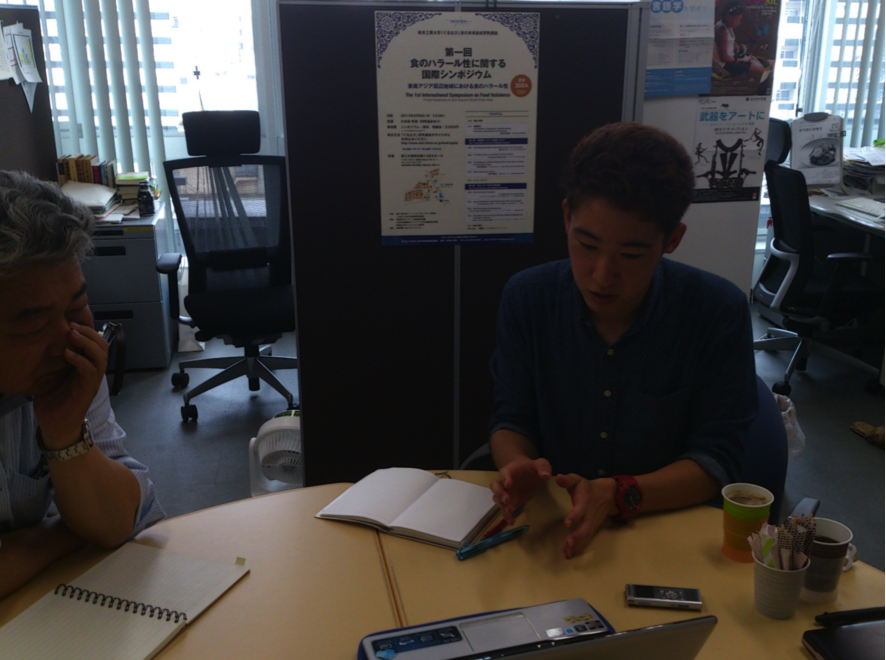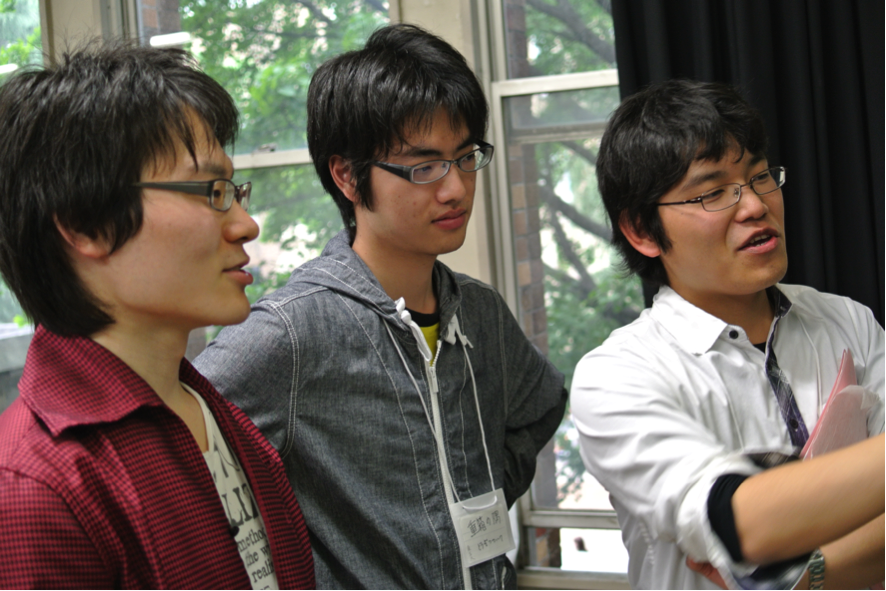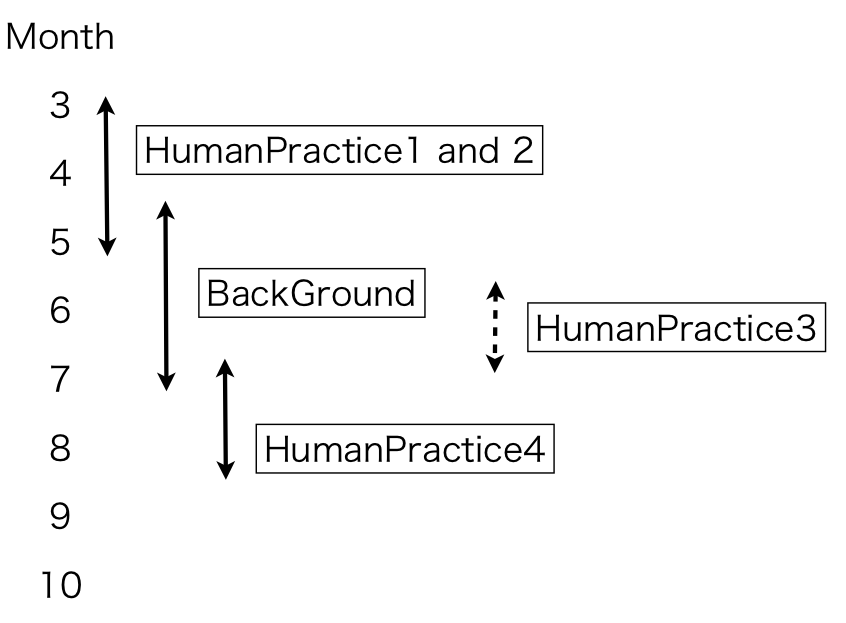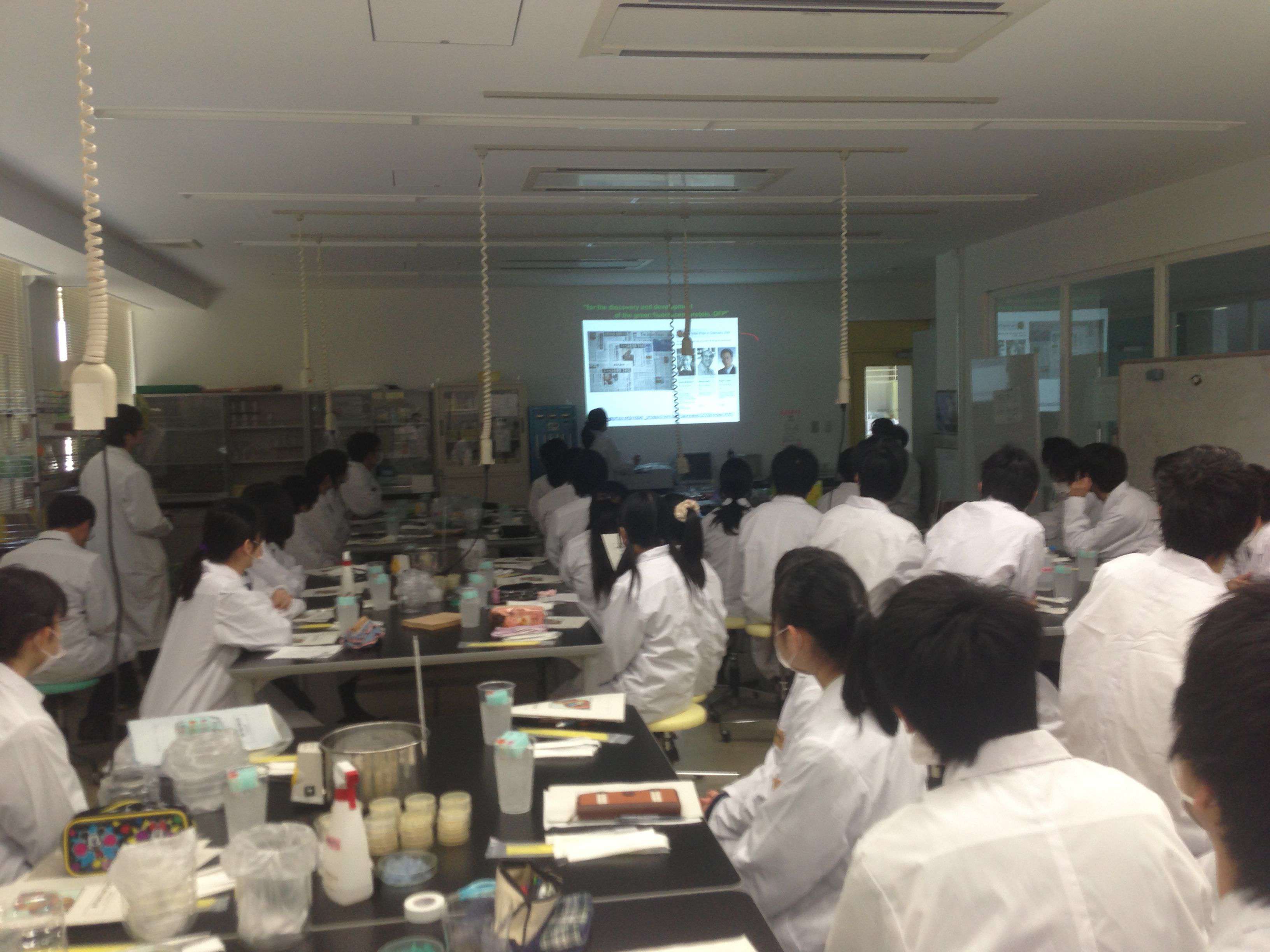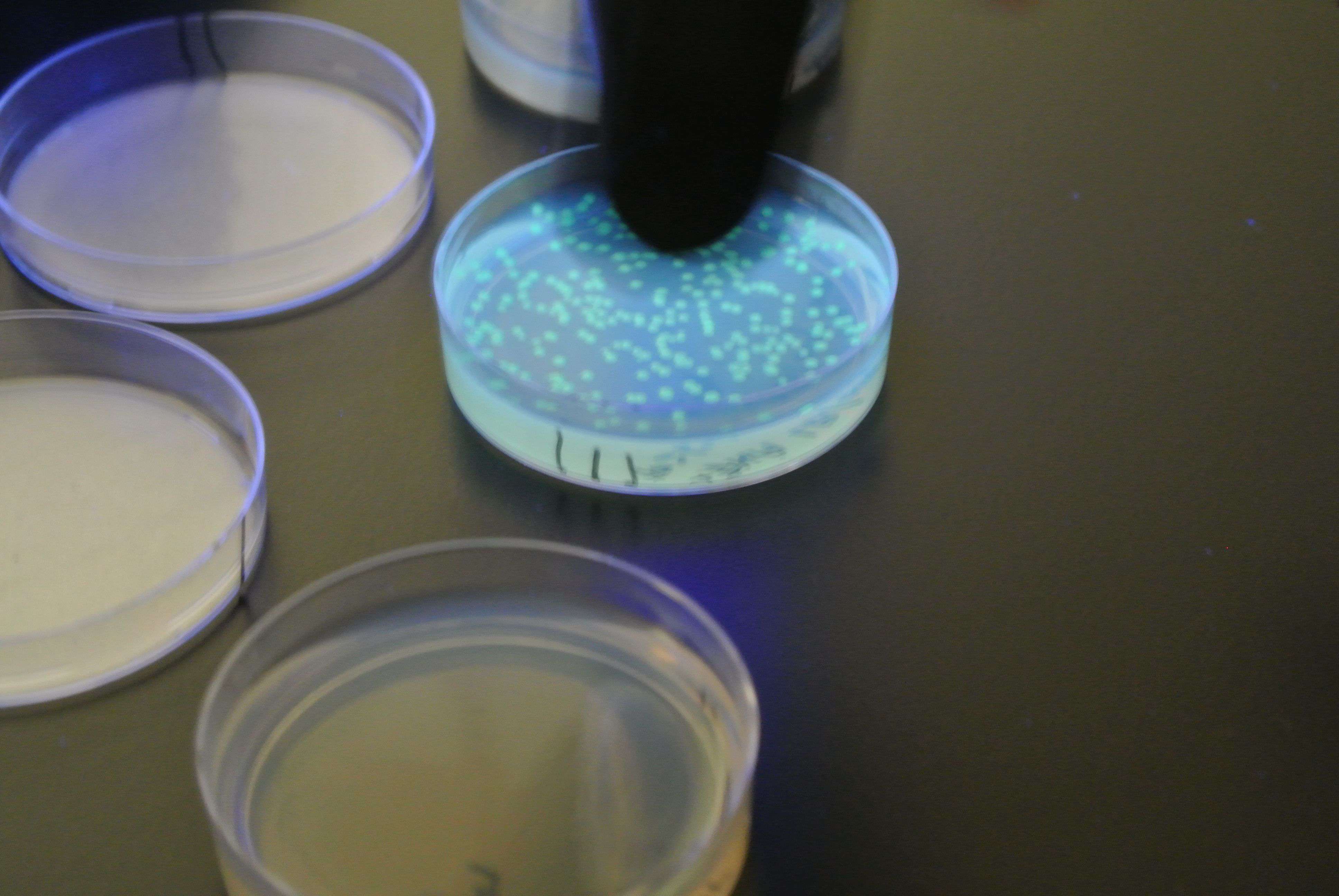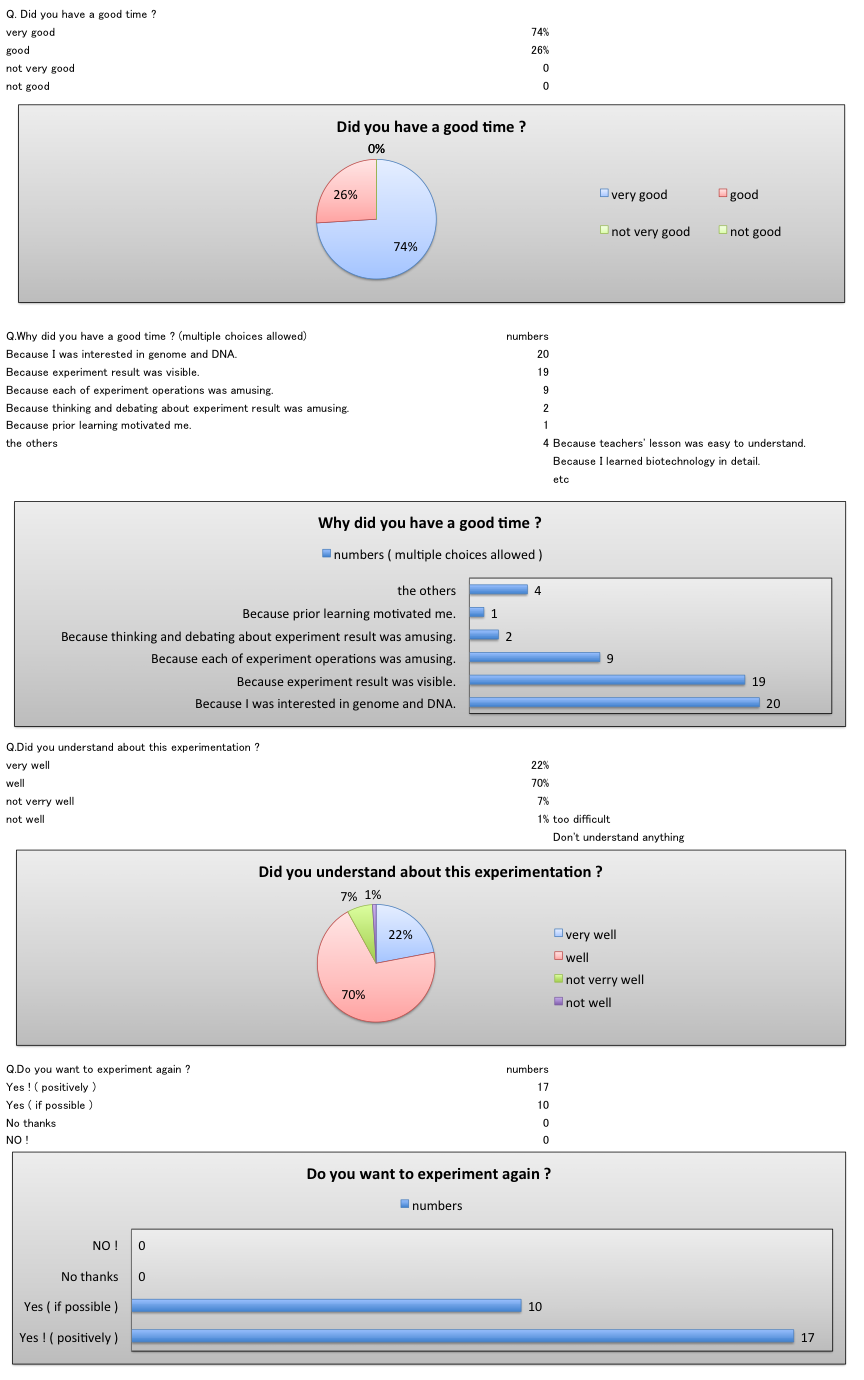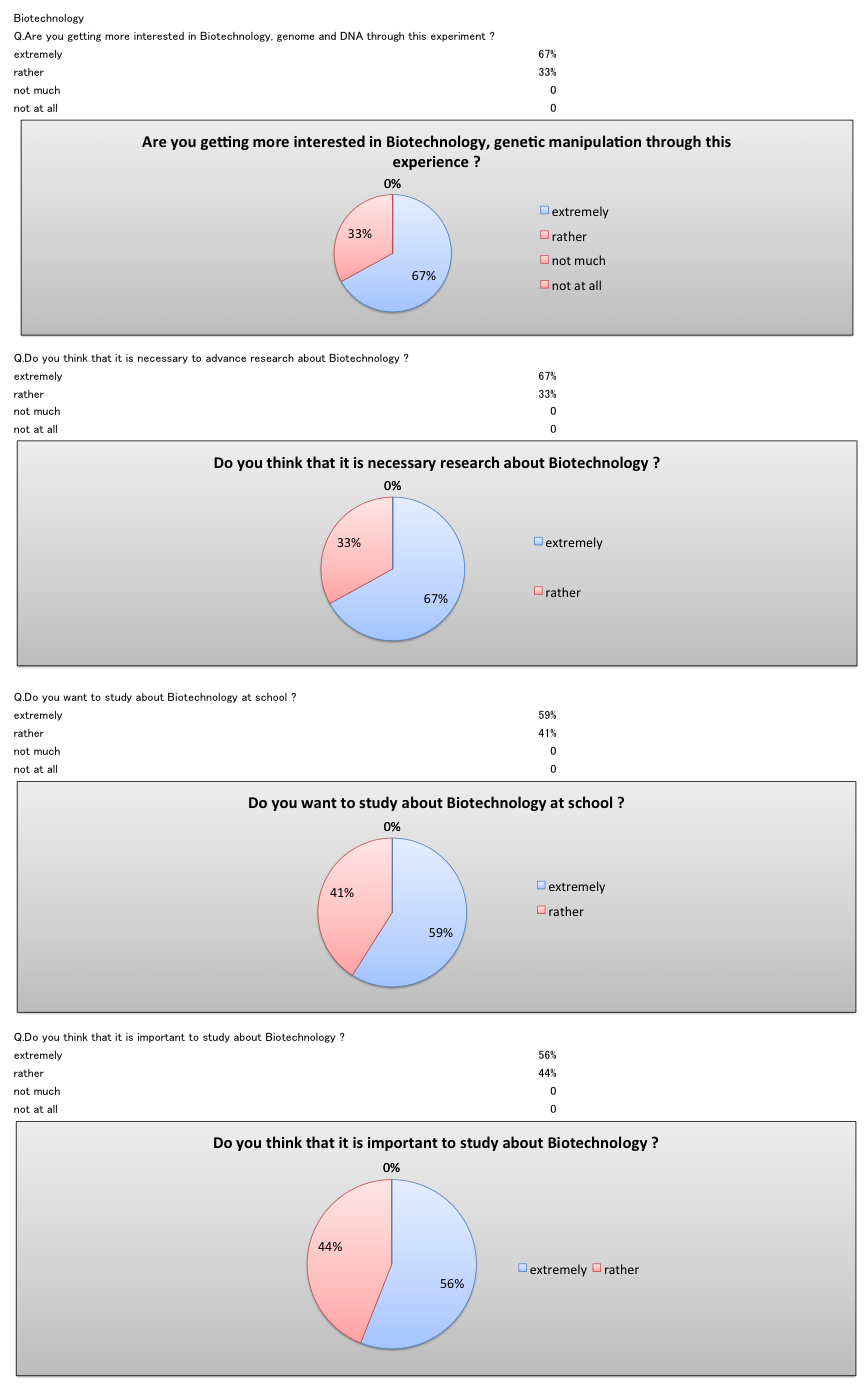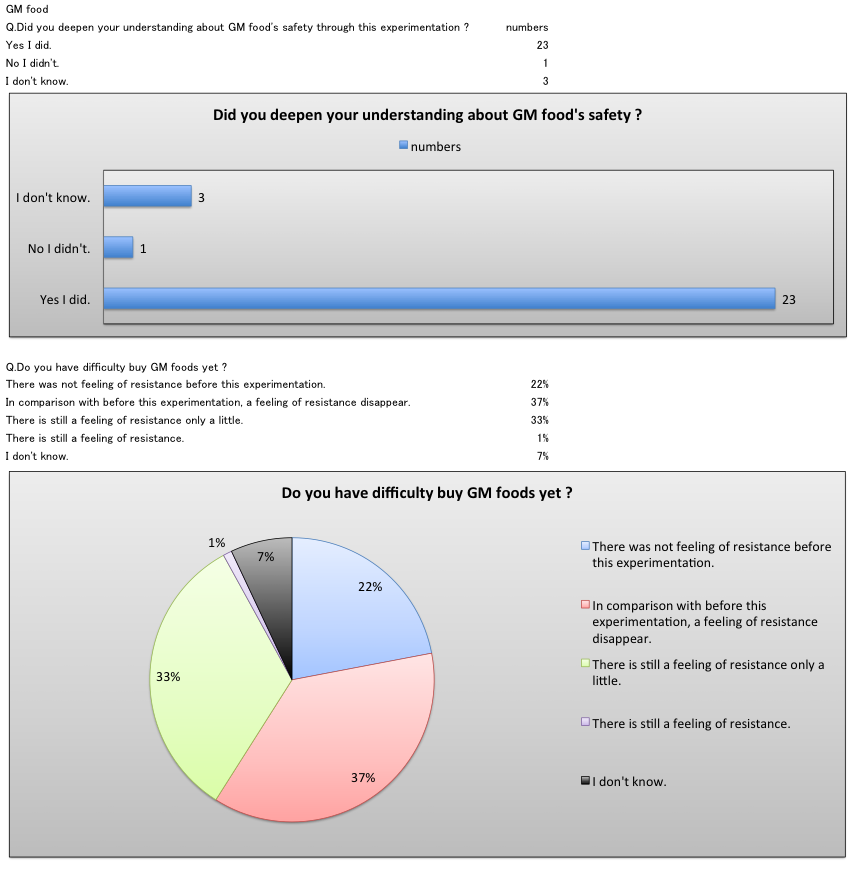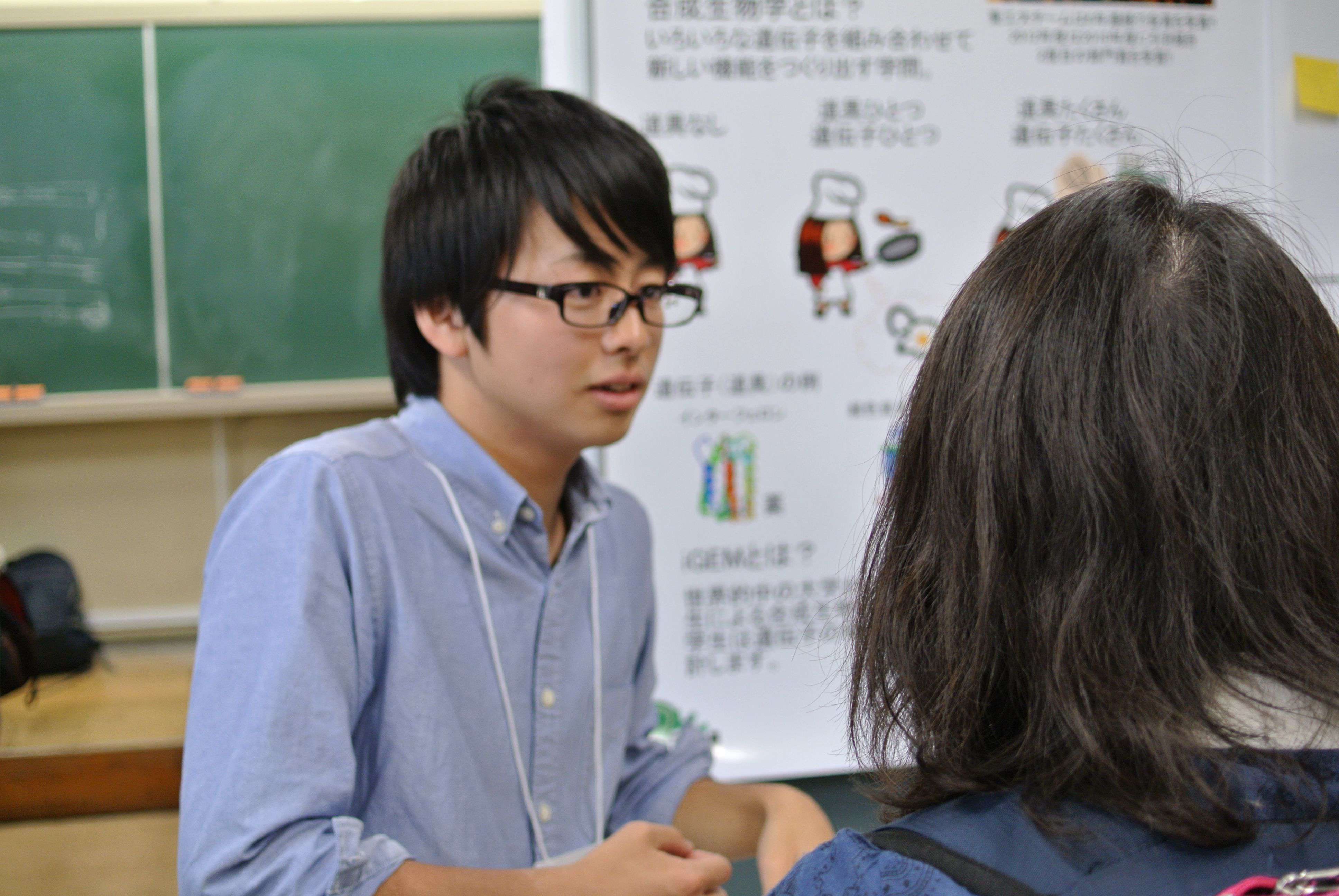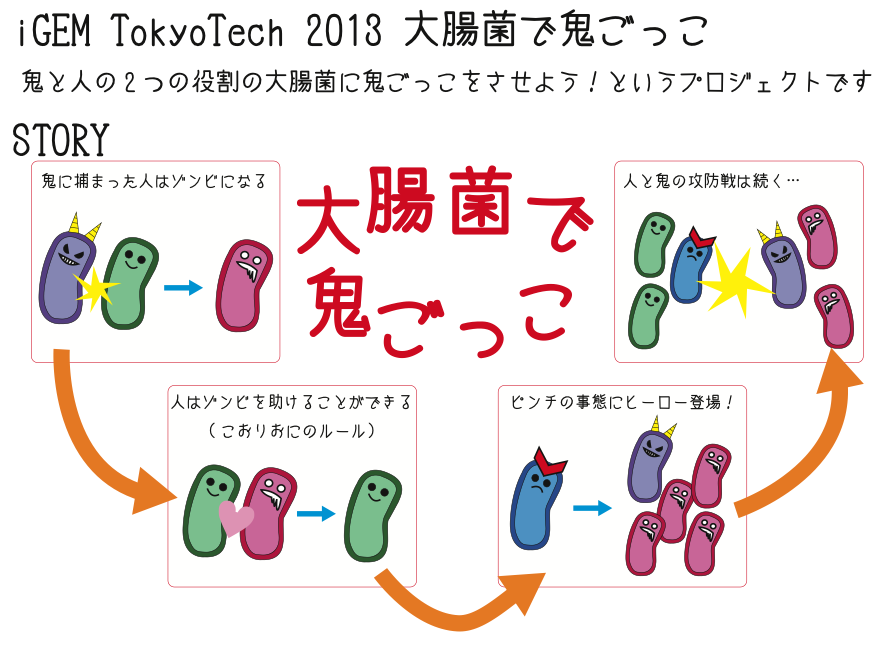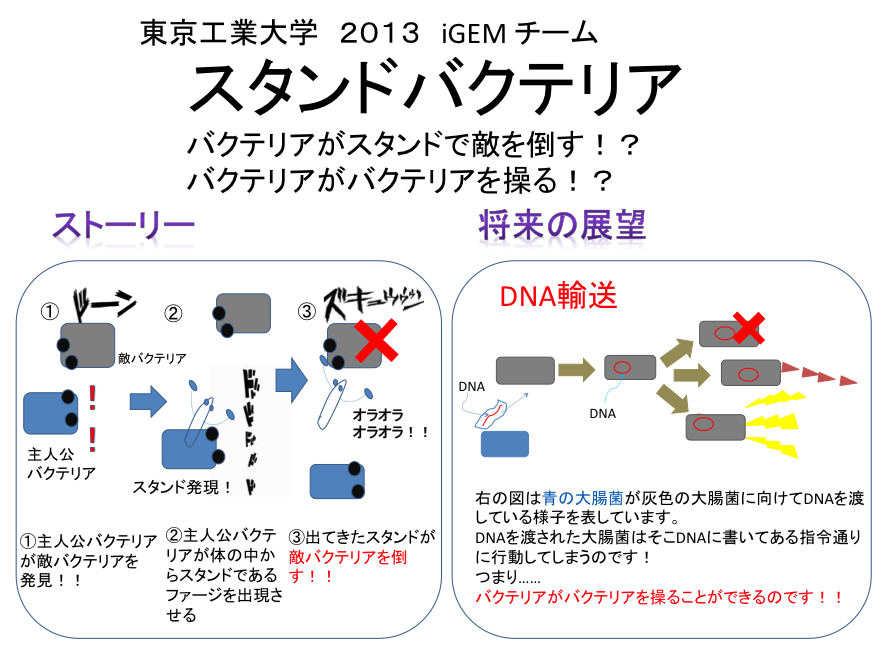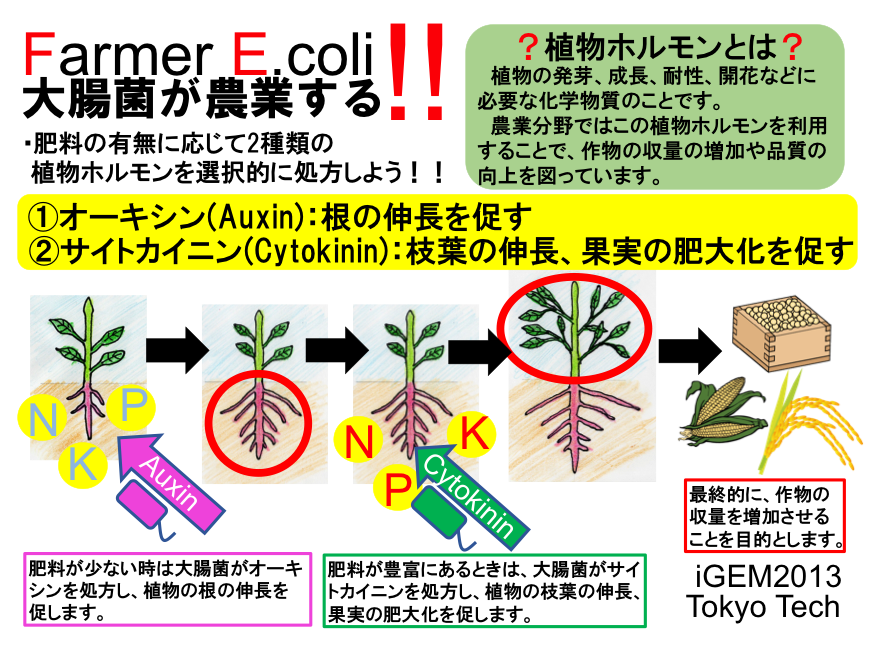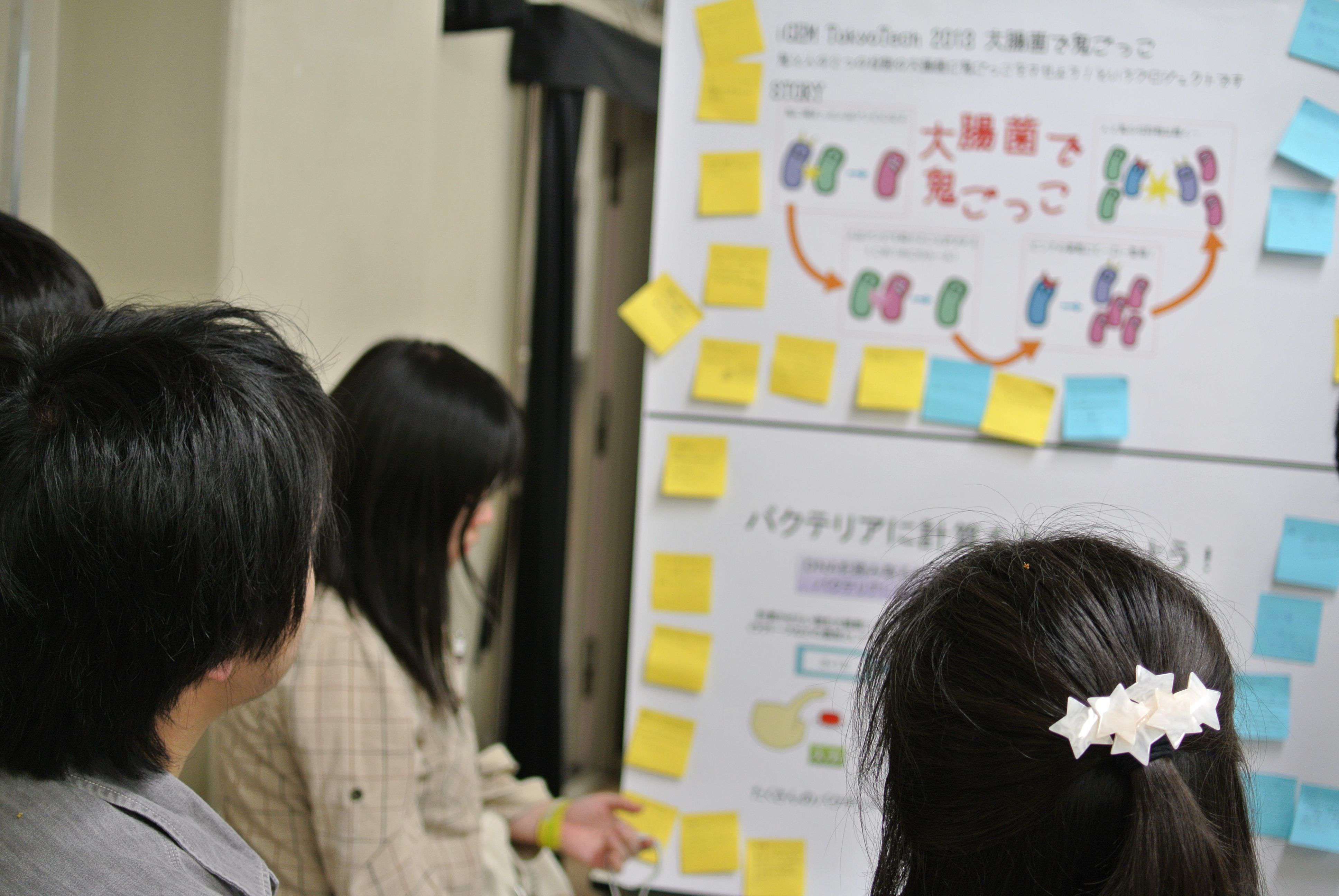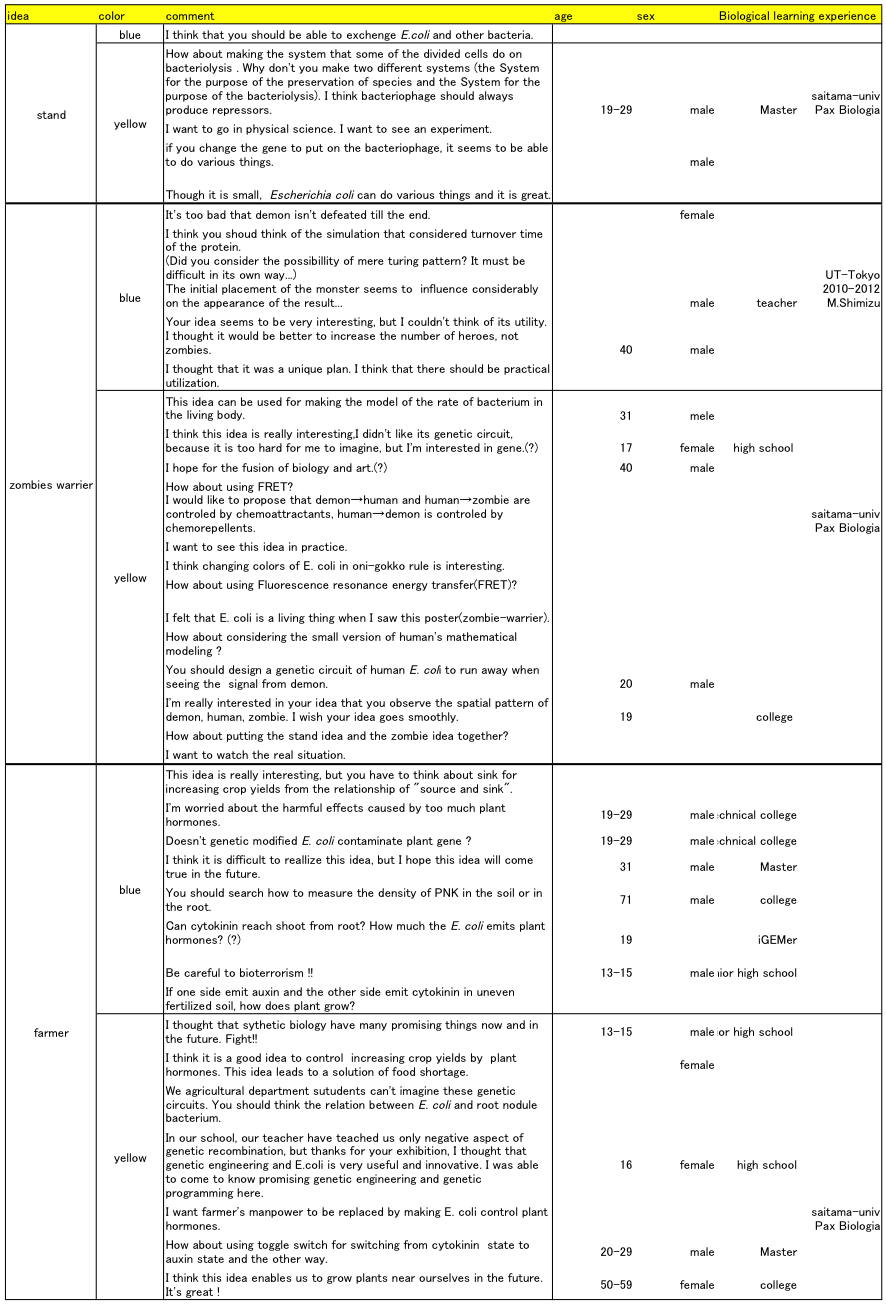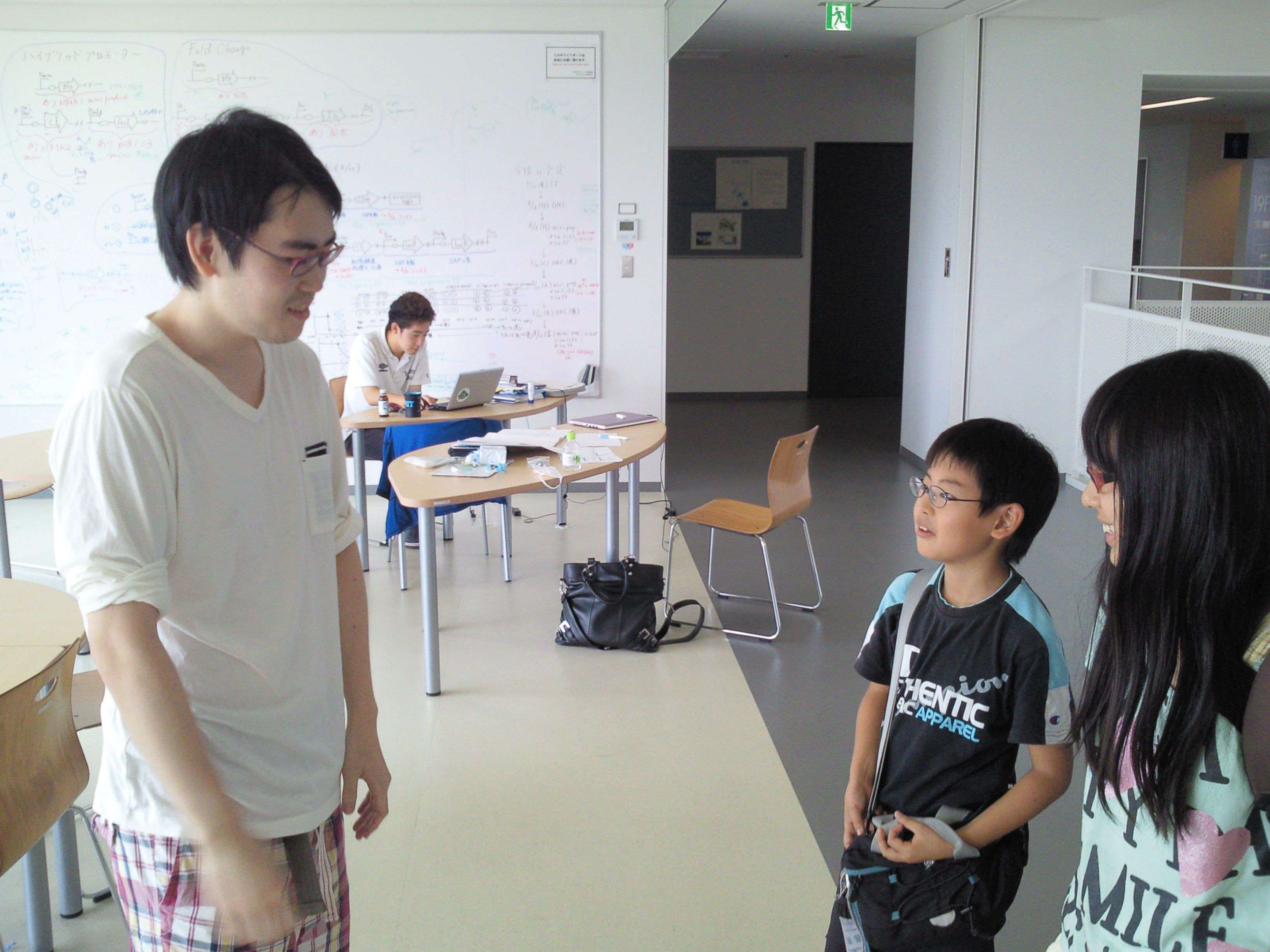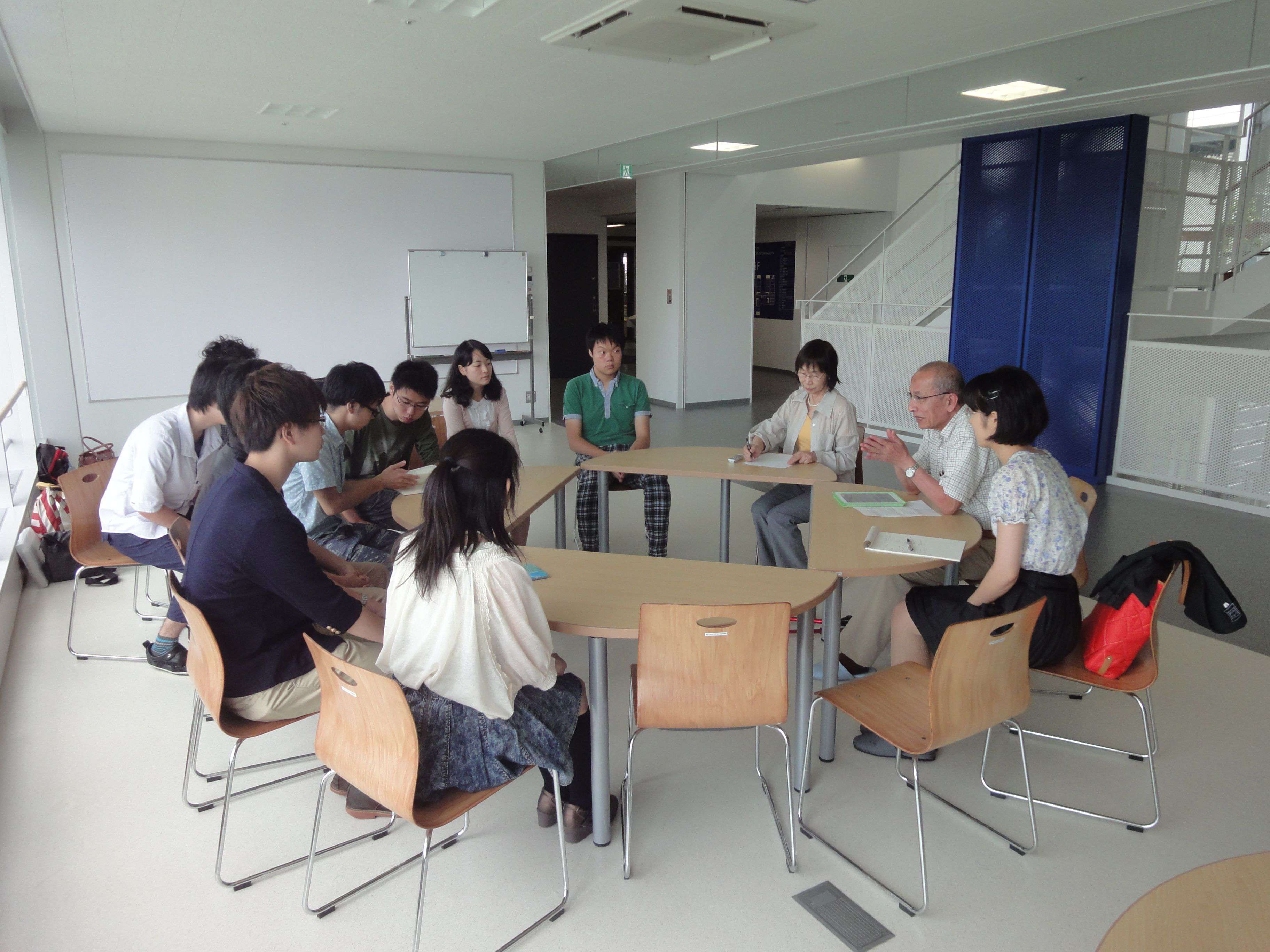Team:Tokyo Tech/Human Practice
From 2013.igem.org
Human Practice
1. Introduction
We hope that we contribute to social recognition of synthetic biology. However, once we tell that synthetic biology is a field of genetic engineering, they ask us, “What can we do with genetic manipulation? Isn’t it disturbing nature law? What benefits does it bring to us? Doesn’t it harm us? ”.
It is natural for general people to have these questions. Furthermore, it is understandable that a phenomenon, which looks natural for students majoring in one field, does not always look reasonable for ordinary people. As for biotechnology, which handles life, medicine, and food, there are many gaps between what general people focus on and what students studying biology like us focus on. These gaps are due to complex of several factors such as health problems, environmental problems, and ethical problems.
Let’s think of the word “Genetic Manipulation”. What image do general people and students studying biology have on this word? Many students studying biology use the skill of genetic manipulation for further developments in science after understanding the ethical problems and other weak points. This means they know that the value of data and life which they can get from genetic manipulation is much bigger than the risk of genetic manipulation. On the other hand, general people have few chances to learn about genetic engineering. In short, they have almost no opportunities to think of the value that can be given from genetic manipulation. Therefore, their image is filled with doubts as we mentioned in first paragraph.
Here we show two examples of biological problems in Japan.
The first example is GM food. GM food often gets into the news. In Japan, every food made from grains is required by law to print whether it includes transgenic grains or not. Therefore, consumers can buy food with relief. Many consumers learn about only superficial genetic manipulation in school and society. This is why people began to focus on only the downside that many living things which have manipulated genes harm human or the environment. In the end, many people began to refuse GM food without thinking.
The second example is that general people don’t have good impression of E. coli. E. coli is famous as enteric bacteria, and it calls up suggestions of the dirt. Therefore, most people think E. coli is dirty. In addition, mass media reported food poisoning by O-157 strain a lot few years ago. This made general people have much more hatred of E. coli.
As stated above, Japanese society tends to focus on only the bad side of biotechnology. GM food actually give us a great benefit, but sadly, ordinary people tend not to know this fact. Under this society, we set our purpose in stages to achieve our goal of spreading synthetic biology.
Firstly, we found out that to what extent the usability of genetic manipulation tand E. coli are known in public. Furthermore, we collected public opinions on synthetic biology or biotechnology.
-->Human Practice1 and Human Practice2Secondly, we reflected the clues that we earned from Human Practice 1 and 2 onto our projects. Moreover, we solved ethical and patent problems on our projects.
-->Back Ground and ProblemsFinally, we brushed up our projects.
-->Human Practice4We fortunately got a chance to spread synthetic biology to general people directly.
-->Human Practice3
2. Human Practice 1: Experiment Workshop
Some members (Shinya Suzuki, Ken Saito, Emma Hatanaka, Yuta Wakabayashi, Naoki Watarai and Tatsuhiro Isozaki) assisted with this experiment workshop. At the workshop, we tried to transform GFP gene into E. coli with high school students for two days. Also, one of our instructors, Prof. Ohta held a lecture about gene engineering and showed his lab to participants.
Participants worked very hard on the experiment, and they listened carefully to Prof. Ohta’s lecture. Some students had studied about gene transformation in advance for this workshop. They asked us a lot of questions and took notes.
3. Questionnaire after the workshop
We requested the participant students to fill in a questionnaire. We got answers from 27 students (out of 41 participants).
3-1. Questions about this workshop
Did you enjoy the workshop?
Why do you think that the workshop was fun?
Were you able to understand contents of the experiment we made on this workshop?
Do you want to participate in workshops like this again?
Respondents answered that they had a good time at the workshop. Most participants answered that they had been interested in biology from the past. The second most answer was that experiment result was visible. They were fascinated by seeing E. coli glowed with green. Other students answered that the lecture was interesting, or they could learn further than their high school classes.
Owing to teachers’ easy-to-understand lecture and many TA’s assists, most participants were able to understand what they were doing on the experiment, but sadly some participants said that they couldn’t. They said the lecture was too hard. However, all students answered that they want to try experiments like this again.
3-2. Questions about biotechnology
Did this workshop give you an interest in biotechnology or gene engineering?
Do you feel the importance of biotechnological research?
Do you feel the importance of studying biotechnology?
Do you want to study biotechnology at your school?
Answers showed that participants had strong interest in biotechnology. We are happy that students became more interested in biotechnology through this workshop.
3-3. Questions about GM food
Did you learn more about GM food’s safety through this workshop?
Do you still have difficulty in buying GM food?
In Japan, it is thought unpleasant to eat GM food. Most participants had some difficulty in buying GM food too. However, following answers showed that many students thought deeply about GM food and they were able to sweep the bad image away by this workshop.
In the first place before most participants know synthetic biology, we think that it was a first step to clear the misunderstanding about biotechnology between the public and who studied biology like us. The workshop was successful.
4. Human Practice 2: Poster session at the University
We have participated in iGEM Japan poster session, which was held at the University’s festival on May 19th. Many Japanese iGEM teams gathered at this event and introduced their project to visitors. Visitors were not only who were concerned to iGEM, there were many general people. Our main purpose was to introduce our projects to general people and ask them how they thought about our ideas.
4-1. How we introduced our ideas to the visitors
We made stories to make our projects more familiar and easier to general people.
・Toggle Switch & Crosstalk : Oni-gokko (like tag)
Oni-gokko is a Japanese game kids play outside. Because every Japanese has experience of playing Oni-gokko, we thought it was a good example to explain the toggle switch system. A human E. coli, a demon E. coli, and a hero E. coli appears in this story. When the human E. coli is caught by a demon E. coli, it turns into zombie E. coli. When the zombie E. coli is rescued by a hero E. coli, it turns back to human E. coli.
・Phage : Jojo
We chose “Jojo’s bizarre adventure”, which is a famous comic in Japan, to introduce our Phage idea. In the comic, a hero handles his guardian angel and defeats many enemies. We likened our story to this comic. A hero E. coli, an enemy E. coli, and a guardian angel phage appears in this story. When the hero E. coli get signal from an enemy E. coli, the hero E. coli release phages and phages lead the enemy E. coli to bacteriolysis.
・Farmer : Farmer E. coli
We are facing the global food shortage problem. Researchers all over the world are now thinking how to cope with this problem. We are also budding researchers. We considered how we can solve this problem from the viewpoint of synthetic biology. We thought that if we could raise the yield to the theoretical value, it would be helpful to solve the problem. To realize this, we had to control plant’s growth according to the amount of nutrition in the soil. Therefore, we proposed a system that if the amount of nutrition in the soil is enough, encourages plants to synthesize “cytokinin,” which make leaves and seeds grow, and if it is not enough, encourage plants to synthesize “auxin,” which make shoots grow to resorb more nutrition. Then how can we tell the amount of nutrition to plants? We make “Farmer E. coli.” Farmer E. coli senses the amount of nutrition and synthesizes either of “auxin” or “cytokinin” depending on the situation to encourage plants’ growth. If we could consign farming to E. coli, it would also be a significant cost reduction too.
4-2. How we asked questions to visitors
First, we explained what iGEM is and the meaning of synthetic biology, and then we introduced our ideas using above posters dependent on visitors’ knowledge of biology. At the end, we asked them for writing their opinions, suggestions, problems and questions in labels and sticking labels on our posters like the picture (Fig. 6-1-11). Positive opinions were written on yellow labels, and negative opinions were written on blue labels.
4-3. Visitors’ reaction
Visitors asked a lot of questions to us. When we said “We are going to use E. coli to realize our ideas,” many visitors asked us, “Isn’t it dangerous to handle E. coli? Don’t you get any diseases from it?” We had to explain the safety of E. coli we use on biological experiments. Furthermore, we had to sweep away the bad image of E. coli and tell the importance of it. What we were most careful to tell these things was to attract their interest in synthetic biology. Because many visitors asked us questions regardless of their age and knowledge, we spent the day with a very rewarding experience. We also got many stimulating opinions.
5. Back Ground
From Human Practice 1 and 2
- We confirmed that most general people have a negative image of genetic manipulation and E. coli in the first place before they know synthetic biology. However, most general people faced our ideas of synthetic biology earnestly. To incorporate plots which tell a story with our ideas is important for helping general people know well about synthetic biology.
- We thought of a solution for the food shortage as a theme for helping general people easily understand genetic programming in synthetic biology.
Synthetic biology is similar to existing genetic modification technology from the perspective that we modify microorganisms by using useful genes. However, synthetic biology is more advanced than existing genetic modification technology from the perspective that we program the relationships among genes on the basis of mathematical-model. We wanted to transmit the advanced point to society as well as enjoy ourselves through iGEM.
When we start up this project, from Human Practice1 and 2, we confirmed that most general people have a biased negative image of genetic manipulation and E. coli by contacting with various general people through the workshop and the poster session. For example, when we explained to general people that E. coli is used in an experiment for our ideas, they said to us, "Is E. coli a unsafe germ, is your body healthy? " When we explained to them about genetic manipulation, they said to us, " Genetic manipulation is not such a difficult operation. Easily making the individual that cannot be in the world formerly make me feel slightly terrible. "
However even people who have negative image of genetic manipulation faced our ideas of synthetic biology earnestly. They also questioned and argued us many times. When the argument was finished, we asked them a question. They said to us with a smile, "Well, I haven't known that E. coli and genetic manipulation are helpful to the development of science! Today, I'm glad to hear that interesting story about progressive synthetic biology! " .
As stated above, the goal of our project is "We solve a general negative image of genetic manipulation and E. coli based upon synthetic biology," that is, "We solve a general negative image of genetic manipulation using microorganisms in biotechnology. ". To achieve the goal, we must reflect the knowledge from Human Practice1 and 2 on our project as much as possible.
Things from Human Practice1 and 2 reflected onto our project- (1) Containing contents that attract many people and help general people understand
- (2) Appealing genetic programming in synthetic biology
- (3) Appealing practical technology in synthetic biology
By adding (1) ~ (3) to our project, we aimed to achieve the goal. For point (1), when we selected stories, we set conditions that contents are famous all over the world and suggestive of Japan. We had many ideas. However, we finally selected "Ninja "story. We thought this story satisfies point (2). There is something fascinating about ecology of ninja. Ninja usually mimics civilian and sometimes attacks evil (samurai in our story) to keep peace from shadow. We thought this switching is applicable to easy explanation of genetic network (toggle switch) system. When we succeed in expressing this ecology of ninja by genetic programming, this project would help general people understand the genetic network programming in synthetic biology.
However, even if we use project "Ninja ," programming of genetic network is not suitable for appealing synthetic biological technology that is easily recognized by many people. Therefore, we started up one more project "Farming" for making practicable to satisfy point (3). In this project, we aim to improve efficient agriculture for coming food shortage.
By making E. coli control plant hormone, regardless of the unevenness of soil fertility, we can improve the yield drastically. Furthermore, making farmer E. coli can reduce manpower. We can implement low-cost and efficient agriculture.
Project "Ninja" and project "Farming" are greatly promising.
6. Problems
6-1. A Solution of the patent problem in our project
Project "Ninja" contains M13 phage infection (the role of shuriken). We constructed gene circuits using M13mp18. We wanted to submit these plasmids as BioBrick part. To submit plasmids on the basis of M13mp18 as BioBrick part, we sent an e-mail to New England Biolabs(http://www.nebj.jp) and finally got permission from this company.
6-2. Thinking about ethical problem on our project
In this chapter, we are going to consider environmental problems in ethical side for our “Farming” project that we aimed to put into practice.
In these days, price of chemical fertilizer is soaring and some developing countries can’t afford them. In this kind of situation we think it might be a great breakthrough to use microbes instead of chemical fertilizer. Microbes will bring us great efficiency in terms of labor, money, and harvest, so even we can cope with the coming food crisis. However, we can never put this idea into practice without thinking of effects that using microbes in open system affect surroundings with the goal of practical applications. We asked Prof. Katayama, who is a professor of Tokyo Institute of Technology Graduate School of Innovation Management, for opinion of the effects that our “Farming” project might affect environment.
One of main obstacles in using microbes in open system is that we can’t decide how to evaluate their safety for environment. If GM E. coli were leaked out from a farm, it would leads to soil pollution. Also it would be invasion of ethic for people living in the surrounding area. GM E. coli are not like GM food, which we can evaluate its safety visually. We can’t see GM E. coli directly. So the biggest problem in our “Farming” project is whether we can evaluate and monitor invisible microbes property.
Then if there were technology that can monitor invisible microbes, would the use in open system spreads over farmers? We think it is hard to make it popular, because few farmers accept the situation that unsure GM microbes are living in their farmland. Many farmers still don’t have a good image to the word “GM : genetically modified”.
How about changing our goal to just use in closed system? Our answer is “No.” In closed system, we can do farming only in limited space. This is the same as giving up our original purpose. We started this project because we wanted to make any land possible to do farming. So we think we can’t go without practical use in open system.
If technology that can monitor microbes directly were established, we couldn’t say that we solved the problem that we use GM microbes in open system without preventing from leaking out to surrounding environment. Also we have to think of genetic transformation among microbes in the system. Furthermore, these settlements have meaninglessness without erasing farmers’ doubts of GM. We were able to find many problems we have to solve through examination of our projects. Though we have to achieve many steps to put our project into practice in open system, we think that “Farming” project is worth overcoming these difficulties.
7. Human Practice 3: Interviewed by The Takeda Foundation.
This June, we (iGEM2012 Tokyo Tech leader Mr. Nakayama and iGEM2013 Tokyo Tech 7 members) were interviewed by The Takeda Foundation briefly. This foundation holds a symposium with various researchers on the basis of an imposing theme every year. Additionally, they publish a summary of the symposium. In one symposium on the basis of "Fluctuation," for example, "Hayabusa”, which is an asteroid probe returned from the universe in June 2010, the origin of the universe and a system of biology were discussed from a viewpoint of "Fluctuation".
A symposium was held about regenerative medicine, experimental physics and synthetic biology on the basis of "Making" in this year. In synthetic biology, the symposium proceeded with Prof. Kiga ,who is our team instructor. Upon publishing a summary of this symposium, they hoped to write an article of synthetic biology that is easy to read for general people who don't know synthetic biology. They wanted to refer to thought of us, who are beginners of synthetic biology. Thereby, we were interviewed by The Takeda Foundation.
7-1. Q. What did you achieve through iGEM?
Mr. Nakayama
iGEM made a change in my study field. Though I had thought to study organic chemistry field originally, iGEM changed my view towards biology. Previously I had an image that all results of biology are not clear. However, I saw cell-cell communication operate genetic program with my own eyes. I found out genetic system has "on" state and "off" state. I became interested in genetic program. Though we used prokaryote in iGEM, I use eukaryote now. I’m studying the cure of cancer on genetic level.
7-2. Q. What are good points of your team?
Mr. Nakayama
Team Tokyo Tech is different from others in Japan. We dare not to allot a part clearly. All member can experiment. All member shares project. All member can fill in for lacked someone.
7-3. Q. How are you managing your project?
Shinya Suzuki
We hold meeting at 18:00 on every Monday. The meetings are usually finished at 21:00. Sometimes the meetings are brought to an end at just before last train. Because team Tokyo Tech is not a club, we don't have a fixed place to work. However, our teachers let us use a room for a rest.
7-4. Q. As beginner of synthetic biology, why do you participate
in this competition?
Shunta Suzuki
Though I'm a junior in Tokyo Tech, I am different from other members. This year I entered here on the process of transfer admission. I was a technical junior college student until last year. I did a graduation research last year. A junior in this college cannot do researches (like graduation researches). Because I worked hard last year, it doesn't satisfy me to pass for this year as just a college student. I wanted to hold research mind. When I thought like this, I knew iGEM.
Sairi Tomatsu
When I was a freshman, I took Prof. Kiga's biology lecture twice. I was interested in Prof. Kiga's research contents and the iGEM competition.
Hengyu Shi
I took part in this iGEM competition as an overseas student. Last year and also the year before last, in this college, overseas students took part in iGEM. After my senior, as a representative of overseas students in Tokyo Tech, I want to challenge world students to compete. Living in Japan, I should know Japanese mind. I want to feel teamwork with Japanese by experiencing various things with my team members. I also want to achieve something cool in college.
When the summary of the symposium on the basis of "Making" is published, a column about this interview will be added to the book on two or more pages. We hope this book will be read by many people and help them know well about progressive synthetic biology and iGEM.
8. Human Practice 4: THE TAKEDA YOUNG ENTREPRENEURSHIP AWARD
Even if we use "Ninja" as our project, it is still difficult for general people to comprehend programming of genetic network in synthetic biology. So we decided to add improving efficiency of agriculture to our project as an approach to practical use side. Our way of thinking was enough to motivate us. However, we eventually wanted our project to become capable of practical application. Therefore, we had to brush up our project to be received in society.
Thereby, we set two goals beyond about another project "Farming".
We have to tell that our project is worthwhile for society. We have to learn defects of our project. We decided to contribute a paper about our project "Farming" to THE TAKEDA YOUNG ENTREPRENEURSHIP AWARD to achieve above two goals.
9. Acknowledgment
To write this report, we got great information.
We really thank to
Prof. Daisuke Kiga
Prof. Hiroyuki Ohta
Prof. Shigeru Katayama
And, all people who participated in our Human Practices.
To write this report, we got great information.
We really thank to
Prof. Daisuke Kiga
Prof. Hiroyuki Ohta
Prof. Shigeru Katayama
And, all people who participated in our Human Practices.
 "
"


